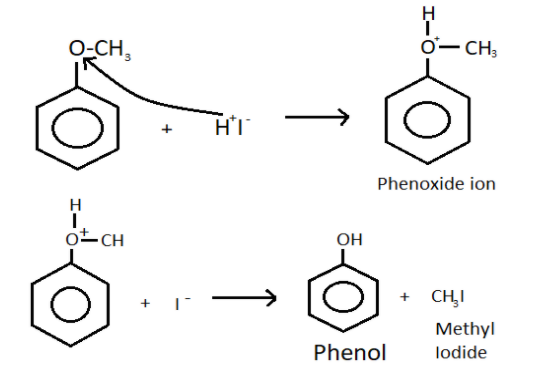
Methoxy benzene on treatment with cold HI produces
A. Iodobenzene and methanol
B. Phenol and methyl iodide
C. Iodobenzene and methyl iodide
D. Phenol and methanol.
Answer
502.2k+ views
Hint: Anisole is the other name for methoxybenzene. When methoxy benzene and hydrogen iodide react together and the bond between oxygen and methyl reacts, it breaks down. The bond between oxygen and benzene does not break because due to resonance it has a partial double bond and hence stronger.
Complete answer:
-When methoxy benzene is treated with cold hydrogen iodide then the bond present between oxygen and methyl group is methoxy group breaks down.
-This leads to the formation of phenoxide ion with the release of methyl ion.
-Now, the hydrogen iodide breaks into hydrogen ion and iodide ion.
-The hydrogen ion now attaches with the oxygen present in the phenoxide ion and forms phenol which have a molecular formula of
-The chemical reaction is:

-Here, the bond formed between oxygen and methyl of the methoxy group is a weaker bond than the bond present between the oxygen and benzene ring.
-Because due to resonance, the partial double bond is present between the carbon of the benzene ring and oxygen.
-Along with the phenol, methyl iodide is also formed because methyl ion was released from the methoxy group and iodine was released by hydrogen iodide, they combine and form methyl iodide.
So, the correct answer is “Option B”.
Note: Resonance is a phenomenon in which the delocalisation of π- bond electrons takes place. Resonance structure having more stability should have a greater number of the covalent bond and least formal charge.
Complete answer:
-When methoxy benzene is treated with cold hydrogen iodide then the bond present between oxygen and methyl group is methoxy group breaks down.
-This leads to the formation of phenoxide ion with the release of methyl ion.
-Now, the hydrogen iodide breaks into hydrogen ion and iodide ion.
-The hydrogen ion now attaches with the oxygen present in the phenoxide ion and forms phenol which have a molecular formula of
-The chemical reaction is:

-Here, the bond formed between oxygen and methyl of the methoxy group is a weaker bond than the bond present between the oxygen and benzene ring.
-Because due to resonance, the partial double bond is present between the carbon of the benzene ring and oxygen.
-Along with the phenol, methyl iodide is also formed because methyl ion was released from the methoxy group and iodine was released by hydrogen iodide, they combine and form methyl iodide.
So, the correct answer is “Option B”.
Note: Resonance is a phenomenon in which the delocalisation of π- bond electrons takes place. Resonance structure having more stability should have a greater number of the covalent bond and least formal charge.
Latest Vedantu courses for you
Grade 11 Science PCM | CBSE | SCHOOL | English
CBSE (2025-26)
School Full course for CBSE students
₹41,848 per year
Recently Updated Pages
Master Class 4 Maths: Engaging Questions & Answers for Success

Master Class 4 English: Engaging Questions & Answers for Success

Master Class 4 Science: Engaging Questions & Answers for Success

Class 4 Question and Answer - Your Ultimate Solutions Guide

Master Class 11 Economics: Engaging Questions & Answers for Success

Master Class 11 Business Studies: Engaging Questions & Answers for Success

Trending doubts
What is the difference between resemblance and sem class 12 social science CBSE

What is the Full Form of PVC, PET, HDPE, LDPE, PP and PS ?

Draw ray diagrams each showing i myopic eye and ii class 12 physics CBSE

Why do the transition elements have higher enthalpies class 12 chemistry CBSE

What are the advantages of parallel combination over class 12 physics CBSE

What are the causes of overloading class 12 physics CBSE




